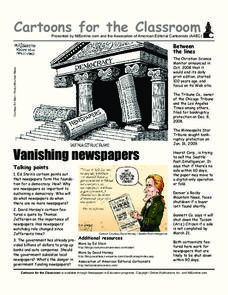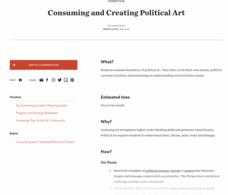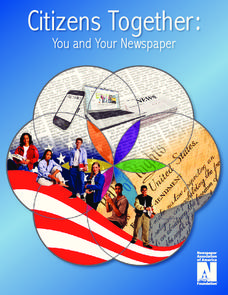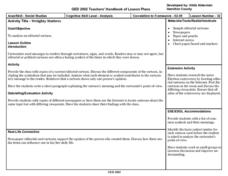Newseum
Decoding an Editorial Cartoon
What advantages do political cartoons have over written editorials? Scholars discuss the topic by exploring editorial cartoons. Working in small groups, pupils analyze an Uncle Sam cartoon and complete a worksheet. As a fun extension,...
Curated OER
Editorial Cartoons
Do your classes love reading and drawing cartoons? Middle schoolers read an editorial cartoon from a newspaper. They discuss the cartoonist's topic, audience, and purpose. Next, they brainstorm questions they have about the cartoon and...
Curated OER
Creating a Cartoon
For this journalism worksheet, students learn the guidelines for creating a political or editorial cartoon. Students complete 5 questions which help them plan the purpose, characters and setting for the cartoon. Students then draw the...
Curated OER
Editorial Cartoon: Censorship
Learners explore the concept of juxtaposition. In this editorial cartoon lesson, students analyze an editorial cartoon techniques to develop an understanding of juxtaposition and symbolism used in the cartoons.
Curated OER
Political Cartoons: Literacy
Readers decode and deconstruct political cartoons to heighten critical thinking, extra-textual literacy, and making meaning from symbolism and metaphor. A compatible activity to use in English class when your 8th or 11th graders are...
Curated OER
Cartoons for the Classroom: Vanishing Newspapers
What is happening to our newspapers? In the context of the current trends of media and the ever-declining print news industry, this handout includes two political cartoons for pupils to analyze, both created by artists working for...
Curated OER
It's a Draw!
Students assess the ways in which editorial cartoons, both current and historic, offer insight into events that shape our world. They create a poster that includes a current editorial cartoon and their explanation of the details of the...
Curated OER
Creating Civic Awareness Through Artistic and Literary Forms
Interpret current events using editorial cartoons and other print media. Middle schoolers explore the meanings of literary and artistic terms such as satire, irony, and caricature. They visit internet sites to develop an understanding of...
Madison Public Schools
Journalism
Whether you are teaching a newspaper unit in language arts, covering the First Amendment and censorship in social studies, or focusing on writing ethics in journalism, a unit based on the foundations of journalism would be an excellent...
Curated OER
Cartoons for the Classroom: The Future of Newspapers
Are newspapers dying, or fighting to survive? Give your scholars access to this controversial debate using political cartoons. In this analsyis handout, 2 cartoons display the changing role of newspapers in a world of online media....
Teaching Tolerance
Consuming and Creating Political Art
A picture is worth a thousand words, but political art may be worth even more! After examining examples of political cartoons, murals, and other forms of public art, class members create their own pieces to reflect their ideals and...
Curated OER
No Joke - My Voice Counts!
Students respond to cartoons. In this social and cultural issues lesson, students examine how cartoons can be used to get a message across to the reader. After examining numerous cartoons, students create their own cartoon with a social...
Curated OER
Canada's Press: Making a Historical Newspaper
Students examine several colonial-era editorial cartoons. They evaluate the effectiveness of the techniques the cartoonists used to display their messages and share one editorial cartoon with the class emphasising what message has been...
Curated OER
Don't Lose Your Way in the News
Young scholars explore language arts by participating in a newspaper analysis activity. In this journalism lesson, students identify how newspapers present stories, who is writing them and how they can obtain information from...
Newspaper Association of America
Citizens Together: You and Your Newspaper
Not all news in a newspaper comes in the form of a traditional article; photographs, charts, and even editorial cartoons help spread important information, too. A civics-based unit describes the parts of the newspaper as tools for...
Media Smarts
Tobacco Labels
Adolescents compare and assess the efficacy of tobacco product health warning labels from around the world. In groups, they invent warnings and create labels that would be effective for teens and children. Discussion covers advertising...
Curated OER
Weighty Matters
High schoolers analyze political cartoons, and write short paragraphs explaining the cartoon's meaning and the cartoonist's point-of-view.
Curated OER
Political Cartoons
Pupils explain that a political cartoon is very much like an editorial--both present personal opinions. Each student writes an editorial that supports the political cartoon. They must analyze the cartoon in order to write about the subject.
Pulitzer Center
The Paradise Papers: A Lesson in Investigative Journalism
The Paradise Papers, a year-long research project from the International Consortium of Investigative Journalism (ICIJ) exposed how political leaders, business people, and wealthy individuals used offshore entities to avoid taxes and hide...
Curated OER
Drawing on Terror
Students assess the ways in which editorial cartoons offer insight into events that shape our world, specifically focusing on the September 11, 2001 terrorist attacks on the United States.
Curated OER
Let the Pictures Tell the Story: Presenting a Point of View
Ninth graders examine the process of writing a newspaper article that presents a point of view. They read various newspaper articles, analyze methods of persuasive writing, interpret and create editorial cartoons, and write an editorial.
Curated OER
Fact or Opinion?
Third graders design a political cartoon. In this fact and opinion lesson, 3rd graders examine political cartoons and distinguish fact from opinion. Students create a political cartoon on the topic of their choice.
University of Pennsylvania
Using Comic Strips to Teach Multiple Perspectives
Scholars view comics from two different perspectives; one paints the Alfred Dreyfus as innocent, while the other portrays the exact opposite. They solve the mystery of what happened by analyzing the source, working in groups, and...
Curated OER
Through the Eyes of Others
Learners consider perspective as they analyze a political cartoon. In this media awareness lesson, students use the provided discussion questions to explore the meaning of the political cartoon "The Scream," by Edvard Munch.
Other popular searches
- Editorial Cartoons & Comics
- Editorial Cartoon Symbols
- Editorial Cartoons Geometry
- Political Editorial Cartoons
- Editorial Cartoon Lessons
- Analyzing Editorial Cartoons
- Irony in Editorial Cartoons























